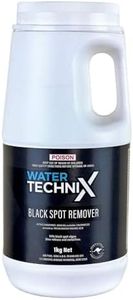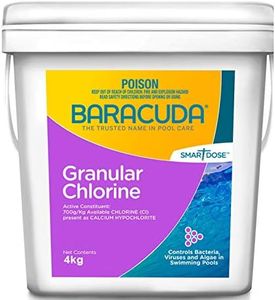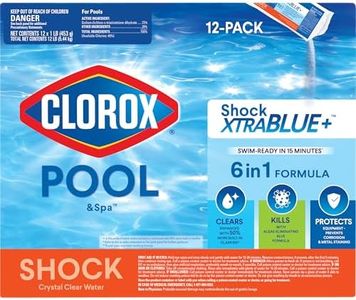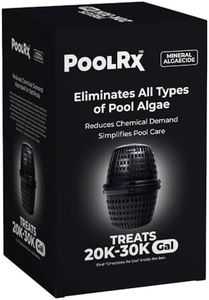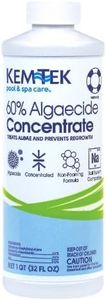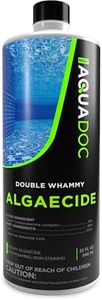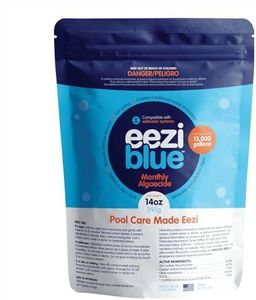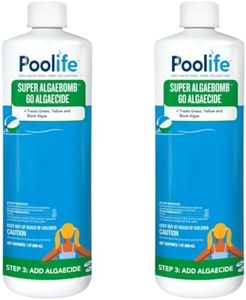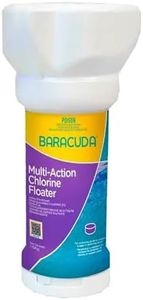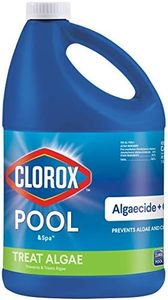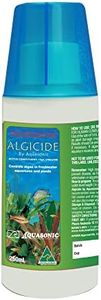We Use CookiesWe use cookies to enhance the security, performance,
functionality and for analytical and promotional activities. By continuing to browse this site you
are agreeing to our privacy policy
10 Best Pool Algae Killer
From leading brands and best sellers available on the web.By clicking on a link to a third party's website, log data is shared with that third party.
Buying Guide for the Best Pool Algae Killer
Picking the right pool algae killer means more than just grabbing the first bottle you see. It's important to think about the type of algae you have, your pool's size and material, and how you plan to use your pool after treatment. Some algae killers work fast but might not be safe for immediate swimming, while others are more gentle but take longer to show results. Always read the product directions and safety info, and don't forget to keep up regular pool maintenance to prevent algae in the future.Active Ingredient TypeThe active ingredient is the chemical that targets and kills algae. Common types include copper-based compounds, quaternary ammoniums, and polyquats. Copper-based algaecides are usually effective on a wide range of algae, but can stain if overused. Quats tend to be less likely to cause staining and can prevent algae but might cause foaming. Polyquats are non-foaming and long-lasting but can be pricier. If you have a sensitive pool surface or want worry-free use, polyquat might be best; if combating a serious bloom, copper-based could be a solution. Consider your pool type, desired speed of results, and concerns over staining or foaming when choosing.
Algae Type CoverageDifferent products are formulated to target green, black, and yellow (mustard) algae varieties. Green algae is the most common and easiest to treat, black algae is more stubborn, and yellow (mustard) algae falls somewhere in between. Products will clearly state the types of algae they handle. Identify the algae in your pool and make sure your choice matches its coverage—using a broad-spectrum algae killer is wise if you're unsure.
Dosage and ConcentrationThis refers to how much product you need to use for your pool's volume to achieve results. Higher concentrations usually mean less product per treatment, but they might require careful handling. Low concentration products may be easier for regular maintenance and pose a lower risk of side effects. Match the dosage requirements to your pool size and consider how often you're comfortable measuring and adding chemicals.
Swimming Re-Entry TimeSome pool algae killers allow you to swim almost immediately after treatment, while others require a waiting period for safety reasons. Fast re-entry options are great if you want minimal disruption, especially during swimming season. If you can close your pool for a day, this may not matter as much. Always follow the printed wait times to protect health.
Pool Surface CompatibilityCertain algaecides work better on specific pool surfaces or liners. Some chemicals can cause staining on plaster, vinyl, or fiberglass surfaces. It's important to check that the product is safe for your specific pool material. If you have a high-end or delicate surface, seek out formulas clearly marked as compatible to prevent damage.
Ease of ApplicationSome products come as concentrated liquids, others as easy-to-use granules or tablets. Liquids might act faster but require careful measuring, while tablets and granules are simpler to dose but might dissolve slower. If you prefer simple, low-fuss application, look for products with built-in measuring devices or those suited for your pool's dispenser.
Additional BenefitsMany modern algae killers also include clarifiers or preventatives that help keep pool water clear or prevent future growth. These extras can save you time and effort by combining several maintenance steps. If you want more than just algae control, scanning for all-in-one products can make pool care easier.
